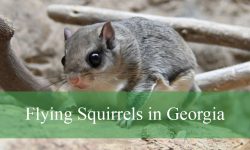North America has over 150 snake species, each with its own unique coloration. Notably, some exhibit striking contrasts, like white snakes with black stripes. These serpents, both native and introduced, display a range of colors and patterns, from striped to spotted or blotched.
The black and white stripes may serve as warnings or aid in camouflage, particularly in dense vegetation. Varying in width and placement, they can start at the mouth or head and extend to the tail.
Additionally, these white and black stripes may be simple, bordered, or interrupted by spots, adding to the intricate beauty and adaptation of these creatures.
Different Types of White Snakes With Black Stripes
Eastern Kingsnake
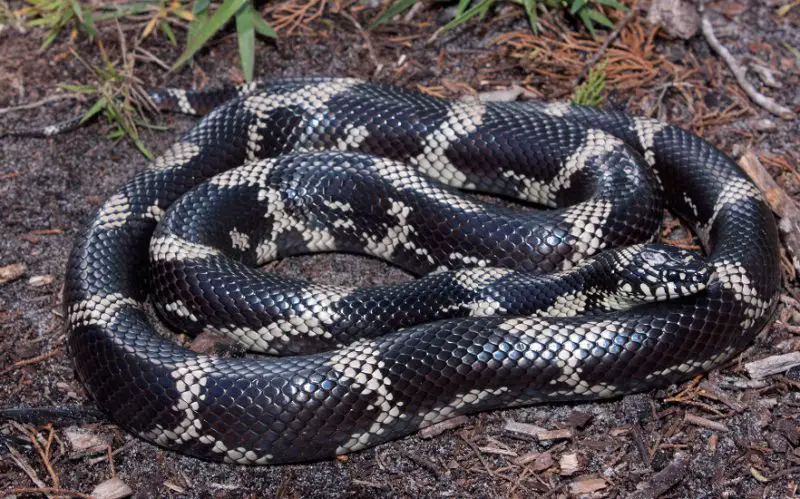
Eastern kingsnakes (Lampropeltis getula) are mostly black with characteristic off-white bands along the length of their bodies. They are sometimes referred to as chain kingsnakes or black kingsnakes. These non-venomous snakes, which can reach lengths of up to 48 inches, are noteworthy for feeding on venomous snakes such as Cottonmouths and Copperheads, which helps to regulate the populations of these snakes.
Especially from August to September, when they lay their eggs, they are frequently spotted beneath logs and rocks. In the winter, they may coexist in burrows with poisonous snakes. Threats to Eastern Kingsnakes include habitat degradation and predation by imported red fire ants; however, they are protected in a number of US states.
Black Kingsnake
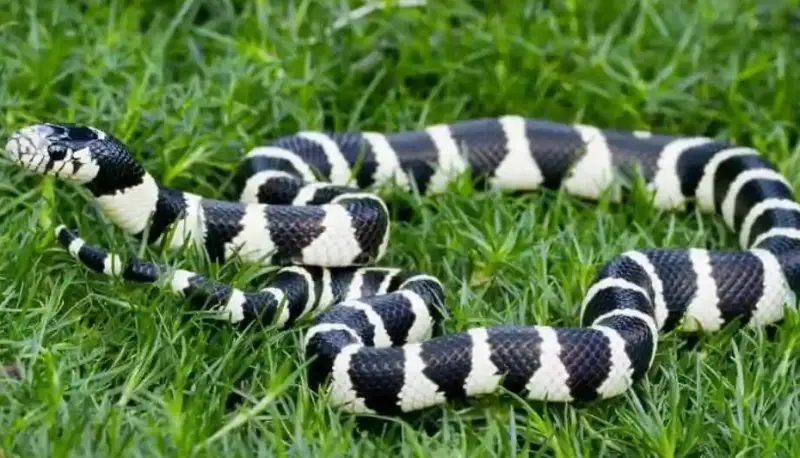
A subspecies of the common kingsnake, the black kingsnake is distinguished by white or yellow-white crossbands or speckles on its body. Though they can be found in woods and other vegetated regions, these non-venomous snakes are most commonly found in streams and marshes.
Black Kingsnakes got their name “King” because they prey on dangerous snakes and are well-known for their resistance to venom. Their ecological significance is emphasized by their capacity to regulate the populations of venomous snakes.
Eastern Milk Snake
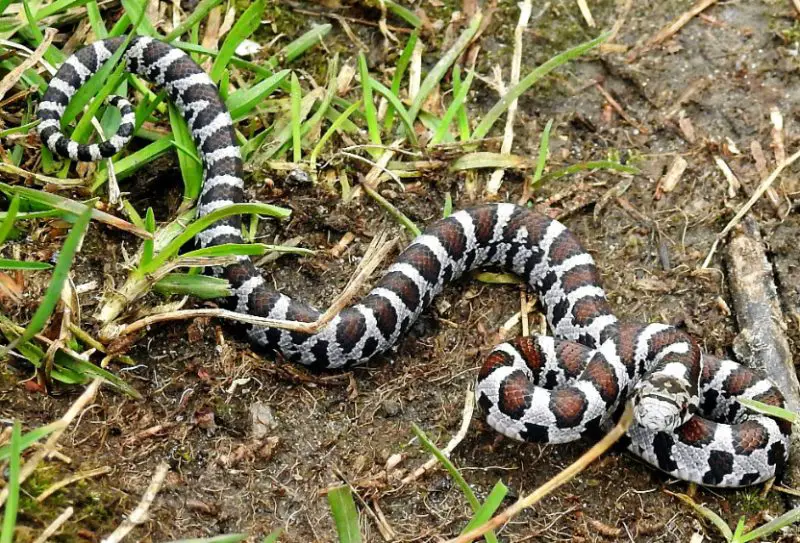
The Eastern Milk Snake (Lampropeltis triangulum), known for its striking appearance, showcases a pattern of alternating bands of red, black, and white scales along its body. Typically measuring around 2 to 4 feet in length, it inhabits various habitats across the Eastern United States and Canada. Its slender build and glossy appearance make it easily recognizable.
It is nonvenomous and docile, it preys on small rodents, making it a beneficial species for controlling rodent populations. Its distinctive coloration sets it apart from other snake species in its range.
Striped Whipsnake
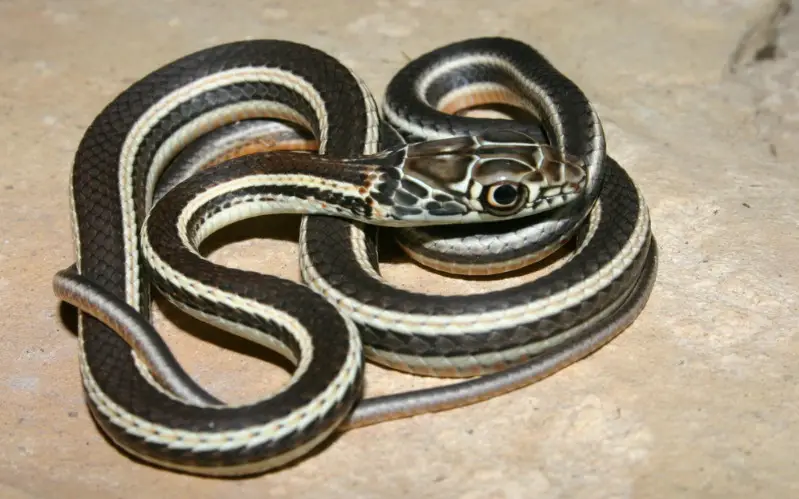
The characteristic white-yellow stripes that run down its dark-to-black body make it easy to identify the Striped Whipsnake (Masticophis taeniatus). These stripes change from yellow toward the tail to white in the direction of the head. They live under rocks, in leaf litter, and in animal burrows. They are well suited to a variety of habitats.
They mostly consume lizards, although they have also been observed to consume other snakes, especially poisonous ones like rattlesnakes. Although non-venomous, Striped Whipsnakes are able to endure the venom of rattlesnakes and frequently feed on young rattlesnakes, demonstrating their incredible adaptation for survival.
Western Massasauga
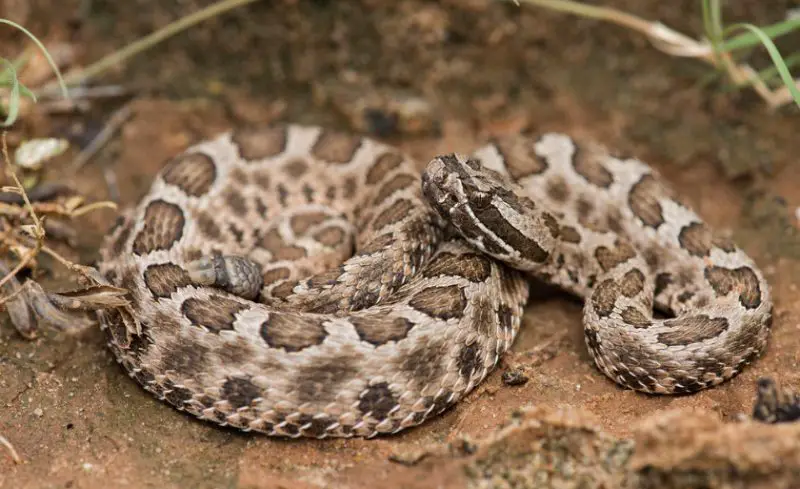
The Western Massasauga (Sistrurus tergeminus) is recognized by its black or brown dorsal blotches outlined in white against a faded gray background. Their coloring can vary slightly based on their environment. These venomous snakes are typically found in marshes during the winter and also inhabit prairies and woodlands.
As a rattlesnake, the Western Massasauga uses its venom to hunt small mammals like rodents. Due to its venomous nature, it should not be handled. Their distinctive pattern and habitat preferences help in identifying this species in the wild.
Pine Snake
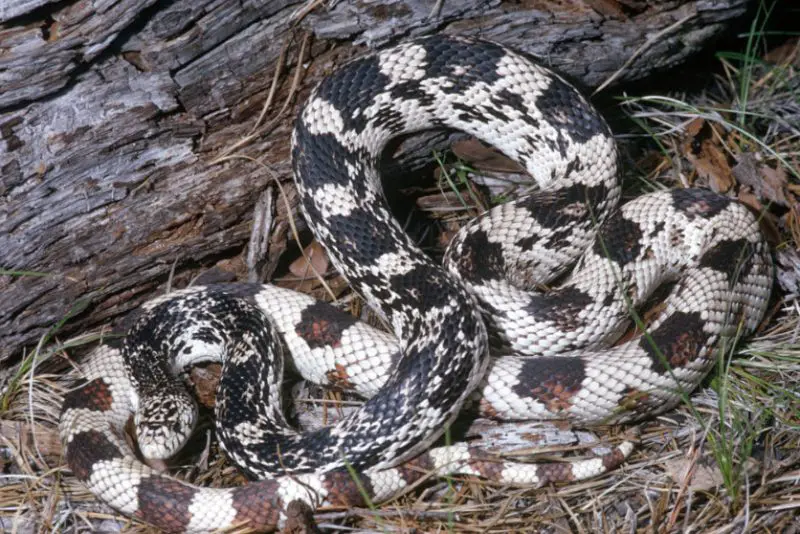
Pine Snakes (Pituophis melanoleucus), also called Black and White Snakes, exhibit a variety of colors, including black and white patterns. These non-venomous snakes use constriction to catch and subdue small mammals, like rodents. They enter the burrows of prey such as rats and mice, where they use their bodies to pin and constrict multiple rodents against the walls, effectively preventing escape.
Known for their burrowing habits, Pine Snakes are skilled hunters that can consume several prey items in one burrow visit, showcasing their adaptability and hunting efficiency.
Puget Sound Gartersnake
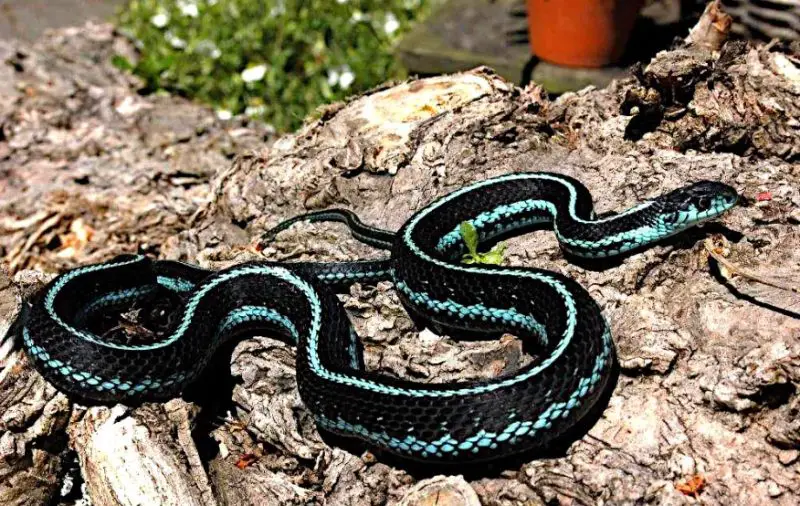
The Puget Sound Gartersnake (Thamnophis sirtalis pickeringii) features black coloring with narrow white, yellow, or blue stripes. Known for its adaptability, this species thrives in various habitats. Unlike many gartersnakes, it has evolved to produce mild venom, posing no significant threat to humans but potentially causing allergic reactions.
This venom is delivered through toxic gums rather than rear fangs. Remarkably, the Puget Sound Gartersnake is resistant to tetrodotoxin, allowing it to prey on toxic salamanders, particularly Newt salamanders, which are typically avoided by other predators.
Gopher Snake
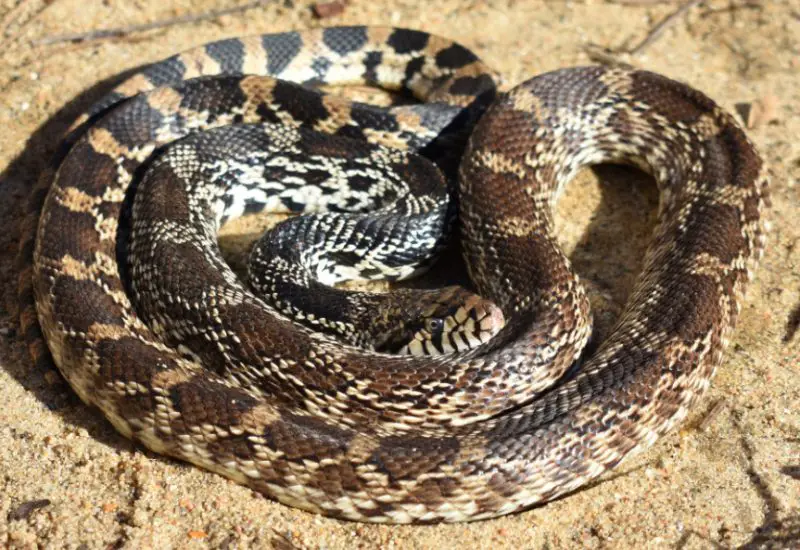
Gopher snakes (Pituophis catenifer), also known as Pacific gopher snakes or bullsnakes, exhibit black and white or beige and brown coloring, often leading to confusion with rattlesnakes. These adaptable snakes are prevalent across various US habitats, from deserts to mountain slopes. Commonly found in marshes, their distinctive black and white blotches make them easily visible.
Gopher snakes primarily feed on rodents and rabbits but will also consume lizards. Their adaptability and diverse diet contribute to their abundance in many states, making them one of the most common snake species in the US.
Black Rat Snake
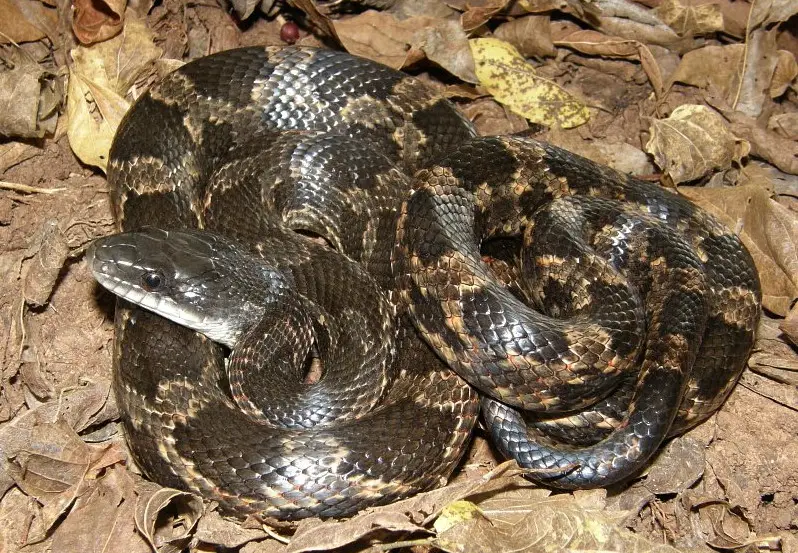
Commonly known as the Western rat snake or pilot black snake, the Black Rat Snake (Pantherophis obsoletus) is easily identified by its almost entirely black body, with a white mouth, lips, and throat visible when it moves. This non-venomous species is a skilled constrictor and climber, often found in trees.
Common across the US, Black Rat Snakes prey on birds and rodents, using their climbing ability to access nests and burrows. Their distinctive coloring and climbing prowess make them a notable and easily recognizable species in their habitat.
Eastern Ratsnake
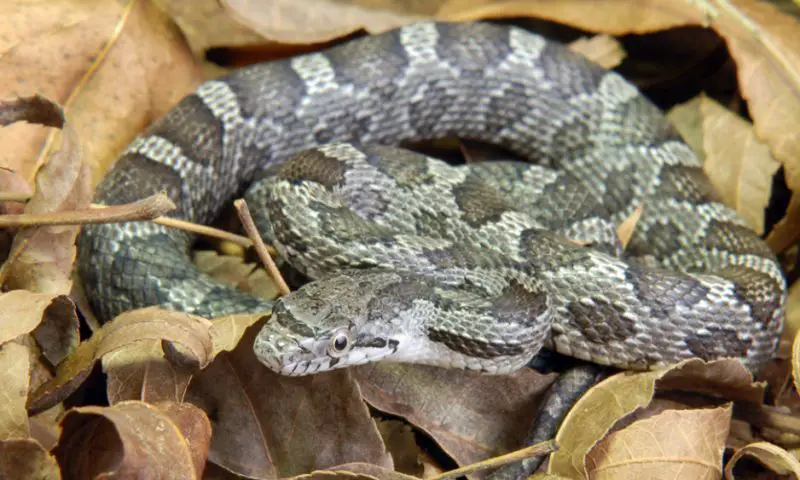
The Eastern Ratsnake (Pantherophis alleghaniensis), also known as the black rat snake or chicken snake, is recognized by its dark gray dorsal coloring and a distinctive black and white chessboard-patterned underbelly. This adaptable species inhabits various environments, including forests, farms, and even residential attics, due to its arboreal nature.
Eastern Ratsnakes seek warm spots for hibernation during the winter. Their diet includes rodents, lizards, and frogs. Common across the US, these non-venomous snakes are effective climbers, often found in high places while hunting or seeking shelter.
Western Terrestrial Garter Snake
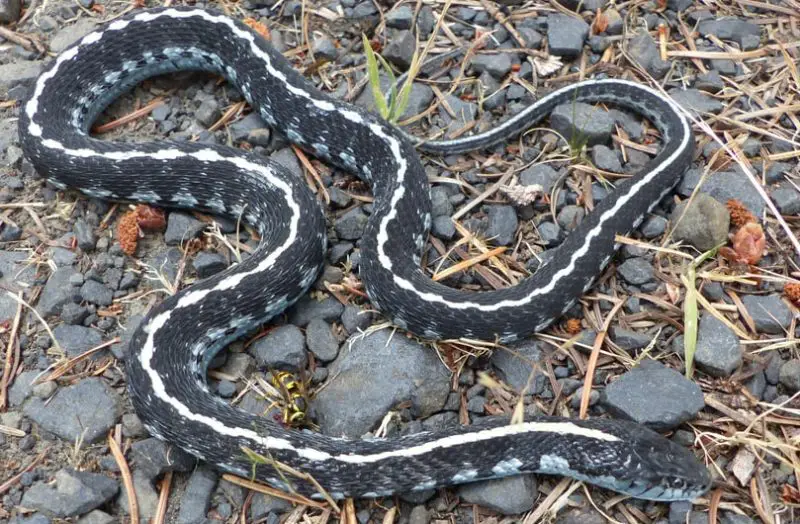
The Western Terrestrial Garter Snake (Thamnophis elegans) displays a variety of colors, commonly featuring black dorsal patterns, a white stripe, and a gray-green body. Some individuals exhibit orange and black patterns with white dorsal lines. Mildly venomous, these snakes possess toxic saliva rather than fully toxic venom, which helps immobilize small prey.
Though generally harmless to humans, bites can cause localized pain or swelling. Adaptable to various environments, these garter snakes are widespread and easily recognizable by their distinctive color patterns and stripes.
Gray Ratsnake
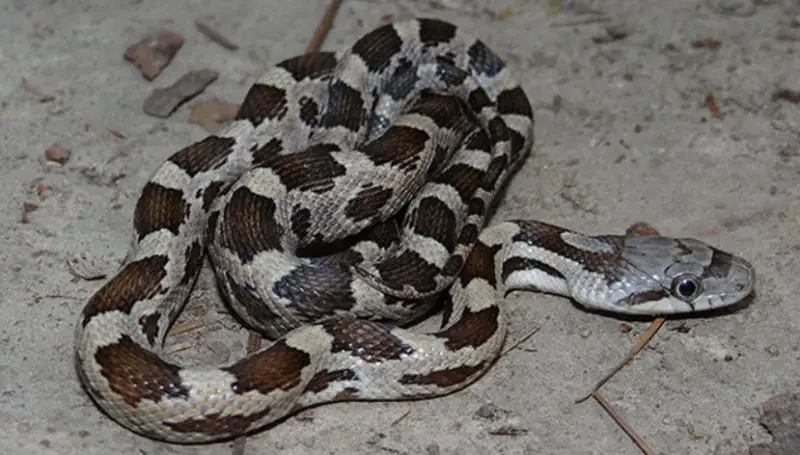
The Gray Ratsnake (Pantherophis spiloides), also known as the Central Ratsnake or Chicken Snake, boasts contrasting colors with a dark gray to black dorsal and a white ventral side. Non-venomous and common in the US and Canada, these snakes prefer forested areas and habitats near streams.
Renowned for their agility, Gray Ratsnakes are adept climbers, utilizing their climbing abilities to hunt prey and evade predators. Their diet includes a variety of birds and rodents, which they capture through constriction.
Easily recognizable by their distinctive coloration and arboreal habits, Gray Ratsnakes play an important role in their ecosystems as both predators and prey.
California King Snake
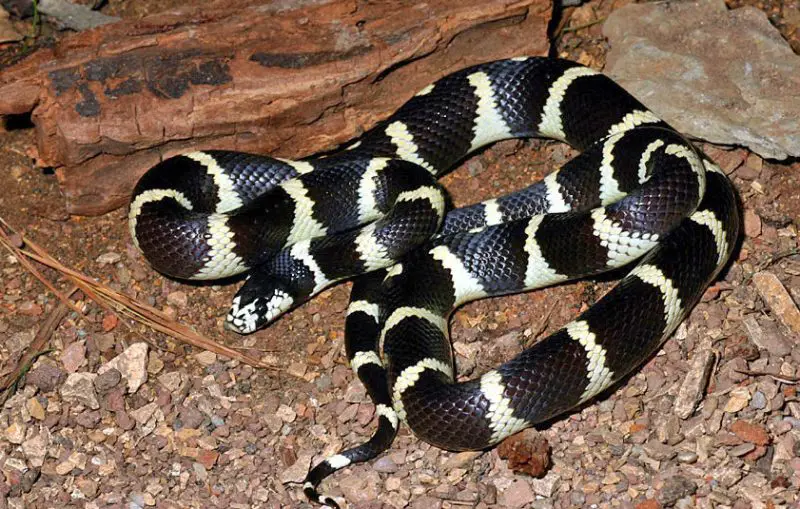
The California King Snake (Lampropeltis californiae) exhibits a range of colors, from pink to dark brown, including a distinctive black and white body with alternating stripes. Non-venomous yet formidable, it possesses the ability to resist and kill venomous snakes through constriction.
While lacking venom, its resistance to venomous bites allows it to overpower other snakes. As one of the largest black and white snakes in the US, it reaches lengths between 2.5 and 3.5 feet.
Known for its striking appearance and adept predatory skills, the California King Snake is a prominent species in its habitat, playing a crucial role in controlling snake populations.
Speckled Kingsnake
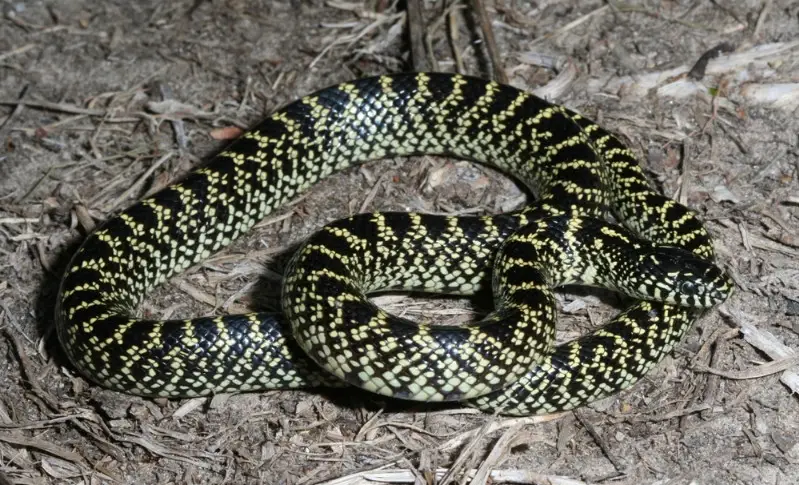
Speckled Kingsnakes (Lampropeltis holbrooki) are distinguished by their speckled black and white or black and off-white bodies, visible on both dorsal and ventral sides. Nonvenomous and commonly found in wet habitats like swamps and rivers, they primarily feed on frogs and lizards, using constriction to subdue their prey.
In addition to their hunting prowess, Speckled Kingsnakes employ defensive tactics such as releasing a foul odor to deter predators. Mimicking death by expelling feces is another strategy employed to evade larger threats.
Their unique coloration and defensive behaviors make Speckled Kingsnakes easily recognizable in their natural habitat.
Long-Nosed Snake
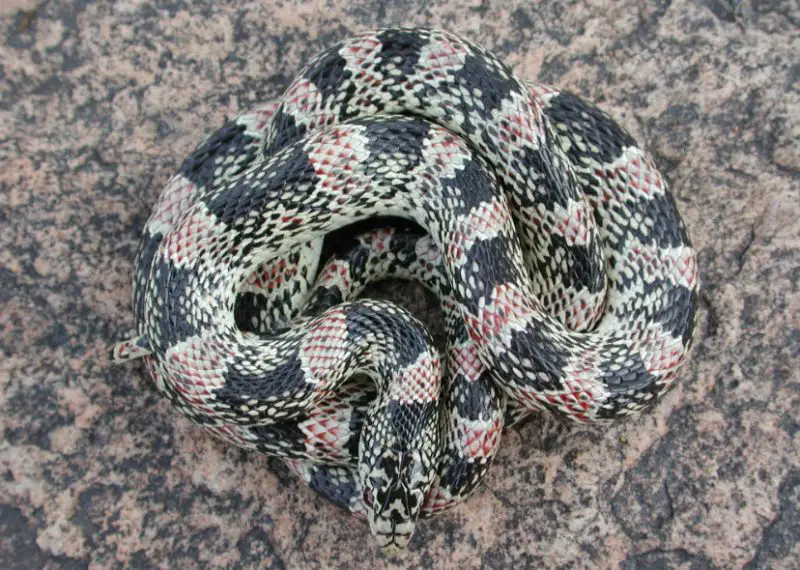
Easily identified by its black and red dorsal banding and white underbelly, the Long-Nosed Snake (Rhinocheilus lecontei) is non-venomous and endemic to North America. Despite its striking appearance, it remains relatively unknown due to its secretive nature, spending much of its time underground. Emerging sporadically to hunt for salamanders, amphibians, and rodents, Long-Nosed Snakes pose no threat to humans.
When threatened, they employ defensive tactics, such as releasing bad odors or blood, to deter predators. Although harmless, their distinctive coloration and secretive behavior make encounters with Long-Nosed Snakes a fascinating experience in North American habitats.
Southern Black Racer
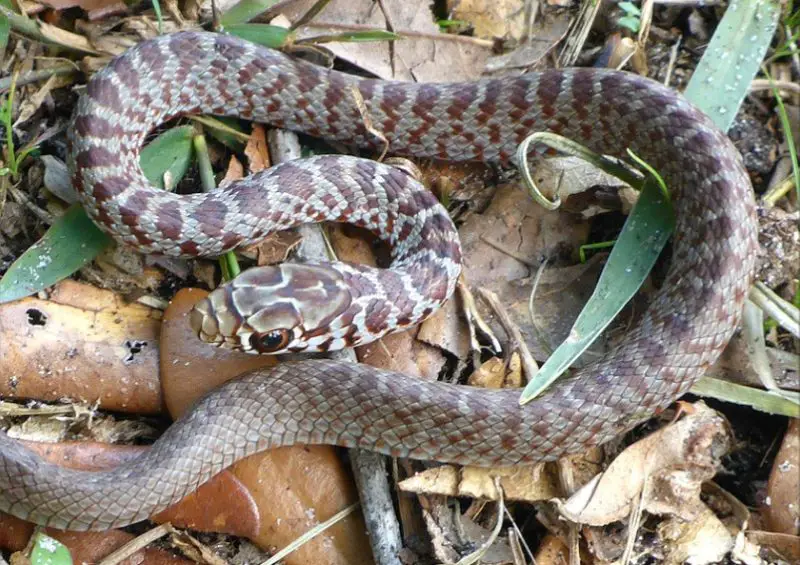
The Southern Black Racer (Coluber constrictor priapus) is distinguished by its almost entirely black body, with a notable white chin and throat. Common throughout North America, it resembles the Indigo Snake but lacks the dark red mouth coloring of its counterpart. Non-venomous and reaching lengths of up to 56 inches, Southern Black Racers feed on a varied diet, including insects, lizards, small snakes, moles, and mice.
They employ constriction to overpower certain prey, particularly rodents, suffocating them with powerful movements. This hunting technique is often utilized when the snake enters rodent nests, making Southern Black Racers effective predators in their ecosystem.


